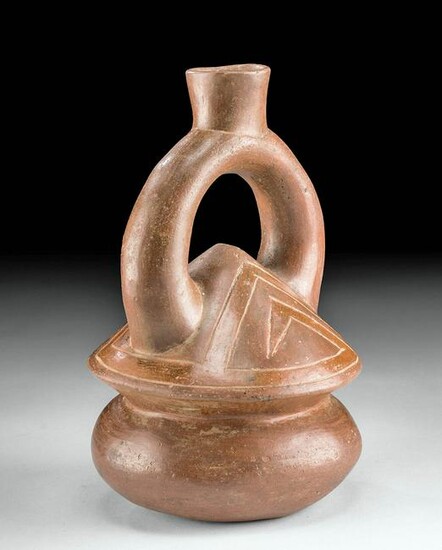Charming Chavin Pottery Stirrup Vessel
Pre-Columbian, North Coast Peru, Chavin, ca. 700 to 500 BCE. A fabulous mold-formed pottery stirrup vessel presenting a two-tiered form that resembles a vernacular house known as a chosa coated in a vibrant hue of sienna under a lustrous burnish. The ancient vessel exhibits a round yet stable base, a bulbous lower tier, and a conical top tier. A lovely incised geometric motif adorns the upper tier of the vessel as a tubular spout with a flared rim arches high over the piece. Size: 4.5" in diameter x 7.5" H (11.4 cm x 19 cm)
The Chavin people lived in the northern Highland Andes, and their capital, Chavin de Huantar, is an UNESCO World Heritage Site. The artwork of Chavin represents the first widespread style in the Andes. The center of Chavin de Huantar is a massive, flat-topped pyramid, surrounded by lower platforms. Between 1200 and 500 BCE the pyramid space was used for religious ceremonies. The Old Temple, constructed very early in the history of the site, consists of a series of passageways built around a circular courtyard; within were carved stone monuments showing jaguars, serpents, and other figures with transformative and/or anthropomorphic features. At the very center is a towering stone stela depicting an anthropomorphic figure with a jaguar head and a human body, believed to be Lanzon, the chief deity of Chavin. Researchers believe that worshippers ingested hallucinogenic drugs and then were led in the dark through the labyrinthine passageways before entering the central courtyard and coming abruptly face-to-face with the snarling features of the god.
Provenance: private Hawaii, USA collection; ex-H.J. Westermann collection, Germany, acquired between 1950 to 1960
All items legal to buy/sell under U.S. Statute covering cultural patrimony Code 2600, CHAPTER 14, and are guaranteed to be as described or your money back.
A Certificate of Authenticity will accompany all winning bids.
PLEASE NOTE: Due to recent increases of shipments being seized by Australian & German customs (even for items with pre-UNESCO provenance), we will no longer ship most antiquities and ancient Chinese art to Australia & Germany. For categories of items that are acceptable to ship to Australia or Germany, please contact us directly or work with your local customs brokerage firm.
Display stands not described as included/custom in the item description are for photography purposes only and will not be included with the item upon shipping.
#162826
Condition Report: Collection label on base. Repaired from a few pieces with restoration over break lines. Expected surface wear with a few light nicks/chips in areas, commensurate with age. Otherwise, excellent with impressive pigments and nice earthen deposits on interior.
View it on
Estimate
Time, Location
Auction House
Pre-Columbian, North Coast Peru, Chavin, ca. 700 to 500 BCE. A fabulous mold-formed pottery stirrup vessel presenting a two-tiered form that resembles a vernacular house known as a chosa coated in a vibrant hue of sienna under a lustrous burnish. The ancient vessel exhibits a round yet stable base, a bulbous lower tier, and a conical top tier. A lovely incised geometric motif adorns the upper tier of the vessel as a tubular spout with a flared rim arches high over the piece. Size: 4.5" in diameter x 7.5" H (11.4 cm x 19 cm)
The Chavin people lived in the northern Highland Andes, and their capital, Chavin de Huantar, is an UNESCO World Heritage Site. The artwork of Chavin represents the first widespread style in the Andes. The center of Chavin de Huantar is a massive, flat-topped pyramid, surrounded by lower platforms. Between 1200 and 500 BCE the pyramid space was used for religious ceremonies. The Old Temple, constructed very early in the history of the site, consists of a series of passageways built around a circular courtyard; within were carved stone monuments showing jaguars, serpents, and other figures with transformative and/or anthropomorphic features. At the very center is a towering stone stela depicting an anthropomorphic figure with a jaguar head and a human body, believed to be Lanzon, the chief deity of Chavin. Researchers believe that worshippers ingested hallucinogenic drugs and then were led in the dark through the labyrinthine passageways before entering the central courtyard and coming abruptly face-to-face with the snarling features of the god.
Provenance: private Hawaii, USA collection; ex-H.J. Westermann collection, Germany, acquired between 1950 to 1960
All items legal to buy/sell under U.S. Statute covering cultural patrimony Code 2600, CHAPTER 14, and are guaranteed to be as described or your money back.
A Certificate of Authenticity will accompany all winning bids.
PLEASE NOTE: Due to recent increases of shipments being seized by Australian & German customs (even for items with pre-UNESCO provenance), we will no longer ship most antiquities and ancient Chinese art to Australia & Germany. For categories of items that are acceptable to ship to Australia or Germany, please contact us directly or work with your local customs brokerage firm.
Display stands not described as included/custom in the item description are for photography purposes only and will not be included with the item upon shipping.
#162826
Condition Report: Collection label on base. Repaired from a few pieces with restoration over break lines. Expected surface wear with a few light nicks/chips in areas, commensurate with age. Otherwise, excellent with impressive pigments and nice earthen deposits on interior.



